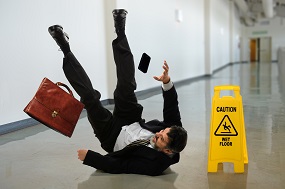Falling Employees Cause Rising California Workers Compensation Insurance Costs – 7 Steps to Prevention
 In the ongoing battle to keep workers’ compensation costs under control, there are many pieces to the big picture, and it can sometimes be easy to overlook the small stuff. We can get so wrapped up in managing claims and dealing with compliance issues, medical treatment, legal hassles, return to work, and a thousand other considerations that we overlook the little things – things like slip, trip, and fall injuries and the steps we could be taking to prevent those injuries from happening in the first place.
In the ongoing battle to keep workers’ compensation costs under control, there are many pieces to the big picture, and it can sometimes be easy to overlook the small stuff. We can get so wrapped up in managing claims and dealing with compliance issues, medical treatment, legal hassles, return to work, and a thousand other considerations that we overlook the little things – things like slip, trip, and fall injuries and the steps we could be taking to prevent those injuries from happening in the first place.
And those little things can have the biggest consequences. How big?
According to the National Floor Safety Institute, slip and fall injuries are the leading cause of:
- Workers’ compensation insurance claims
- Occupational injuries for workers 55 and older
- Lost days from work
This is clearly a risk you need to get under control. How do you do that? Here are seven tips for preventing slip, trip, and fall injuries in your workplace:
- Choose your flooring wisely. Don’t buy flooring simply based on price or appearance. It’s about function and safety. Your flooring should be smooth but not slippery, especially in restrooms, kitchen areas, and at exterior entrances where rain, sleet, or snow can be tracked in. Your flooring also shouldn’t have any joints, ridges, or edges a quarter inch or greater in height that could present a tripping hazard.
- Keep floors maintained. Floors get damaged from buildings settling, items being dropped on them, heavy equipment, and normal wear and tear. Repair any damaged flooring promptly, including frayed carpets or missing floor tiles, and only use cleaners and waxes in accordance with the floor manufacturer’s specifications.
- Require proper footwear. If any of your employees work in areas where there is occasionally water on the floor, spills, or other causes of slippery conditions, require those employees to wear shoes designed with skid-resistant soles and heels. However, all employees should be encouraged to wear appropriate footwear with good tread.
- Set housekeeping rules. Train your employees to properly store materials, supplies, equipment, and tools off of floors. Remove any debris or leftover production waste from floor areas before it becomes a hazard.
- Clearly mark elevation changes. More falls occur with a one-step change in elevation than with full sets of stairs from one floor to another. Steps should always be clearly marked, have slip-resistant material covering them, be well lit, have handrails, and have an even height and width on all steps. Avoid using steps that have the same color or floor covering as the adjacent floor.
- Keep sidewalks and walkways clear. Sidewalks should be smooth but not slippery. Quickly repair any damage from settling, tree roots, or machinery, and remove any accumulation of water from sprinklers, rain, ice, or snow as soon as possible. Clearly mark or correct any elevation changes of a quarter inch or higher.
- Maintain parking areas. Potholes in parking lots and garages can do a lot more than damage a hubcap or your wheel alignment. They’re prime hotspots for trip and fall injuries, especially in the dark. Promptly repair potholes, broken pavement, and other irregularities, brightly mark any parking bumpers, speed bumps, and other potential trip hazards, and keep parking areas well lit.
The best way to cut workers’ compensation costs is to prevent accidents and injuries, and slips, trips, and falls are one of the biggest culprits. Follow these safety tips to help prevent some of the small stuff from becoming big, costly headaches.
Want more ways to slash your workers’ compensation costs? Contact Republic Capital, your California workers’ compensation insurance claims administration specialists.
